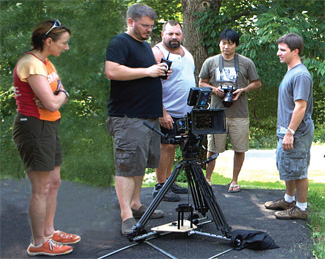Microdolly Supplies HDDSLR 'Missing Link'

Vincent Laforet (second from left) and crew go over details of scene to be shot with Microdolly equipment.
LOS ANGELES
This past year has witnessed a proliferation of the HDDSLR—a term coined to describe digital single lens reflex still cameras that are capable of shooting both conventional photographs and also HD motion video.
I had the chance to use a prototype Canon EOS 5 D MKII more than a year ago and produced a short called "Reverie" that I posted on the Web. More than 1.5 million people viewed this video, which demonstrated the 24 mm x 36 mm sensor and high speed streaming code used.
This camera was a game changer in many ways. Not only did it allow a cinematographer to take advantage of low light shooting conditions such as few cameras can today—its small size and weight (not to mention price) was also an incredible draw.
As I've been an editorial and commercial photographer for the past 19 years, I also have a pretty wide range of Canon still lenses—just about everything from a 7.5 mm to a 500 mm.
Ironically, with this technology, I did manage to hit a certain wall that affected creativity. While the EOS 5D MKII provided incredible performance in low light situations—and at wide apertures—its light weight and small form factor were based on a still photographer's needs, not really those of a videographer. And I found out rather quickly that this was a limiting factor. Pulling off any camera moves, let alone stabilizing the camera—with its huge sensor which is very sensitive to any movement—was particularly difficult. Also, most of my Canon still camera lenses lack optical image stabilization suitable for video applications.
I soon found myself weighing down the camera with accessories and looking at all sorts of dollies and jibs. I also asked myself why would anyone take such a compact camera, with the advantages that brings, and negate these by requiring a truckload of gear and a crew to set down tracks for a simple dolly move. After all, wasn't working with a very small crew and equipment that's light, efficient, fast, and with a small footprint really what I was striving for?
NEW BREED OF CAMERA SUPPORT
Luckily I found Microdolly gear. The moment that I first saw the setup at a DGA event in Hollywood was a "Eureka" moment for me. Not only were the tracks, dolly and jib mechanisms incredibly intuitive to set up and operate, the price proved to be incredibly affordable. The clincher for me was seeing that two-person teams were able to pull off dolly and jib moves in the middle of the Amazon jungle or on the top of Mount Kilimanjaro. A two person team could now realistically pack a dolly and jib kit into two backpacks, and bring along their camera equipment in a third small bag.
The Microdolly system has worked flawlessly for me with both the Canon EOS 5D MKII and EOS 7D. I've attached wireless video transmitters and focusing controls, along with LCD monitors to make camera dolly and jib moves that one would expect to see only in larger productions. The best part of my discovery was that I no longer have to budget major amounts of time and money to add the production value of camera movement to my projects.
Vincent Laforet is a commercial and editorial photographer/filmmaker who works on a variety of fine art, advertising, corporate and editorial projects. He may be contacted at studio@vincentlaforet.com.
For additional information, contact Microdolly Hollywood at 818-845-8383 or visitwww.microdolly.com.
Get the TV Tech Newsletter
The professional video industry's #1 source for news, trends and product and tech information. Sign up below.
